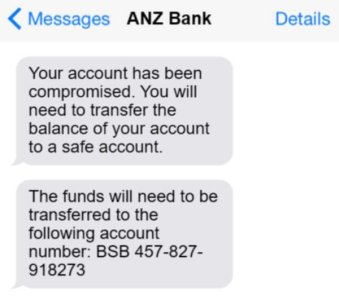Protect your bank account! An Australian lost $130k in four days – find out how to avoid this ANZ scam
Being cautious and vigilant is essential, particularly when it comes to scams—and it’s especially invaluable for those who may be targeted by scammers preying on unsuspecting individuals.
A recent incident in Australia serves as a reminder of the devastating consequences that can arise from falling victim to such heartless schemes.
In this unfortunate case, an Australian businessman found himself ensnared in a scam that resulted in a shocking loss of $130,000 within a mere five minutes.
Paul Trefry, the owner of a well-known animatronics and model-making workshop, shared his story on 2GB's Ben Fordham Live to warn others and encourage them to remain alert.

The elaborate scam involved a text message from what appeared to be ANZ Bank, sent using the same number as legitimate ANZ communications, leading Mr Trefry to believe it was genuine.
The message claimed that his account had been compromised and urged him to transfer his funds to a new, supposedly safer account—which turned out to belong to the scammers.
For a busy businessman like Paul, dealing with such a crisis quickly was a priority. Caught up in the urgency to resolve the issue, he transferred an incredible $130,000 over four days to the fraudulent account.
Unfortunately, ANZ only contacted Paul a week later to inform him that he had been scammed. The bank acknowledged the elaborate scheme copied ANZ's protocols perfectly.
Paul said that the ANZ Rep inquired about a transfer of $17,500 to a different account, to which he explained, ‘Well, guys, I'm just following your instructions,’ Their response was, ‘No, we wouldn’t instruct you to transfer money into different accounts’.
After discovering that his money had been stolen, Mr Trefry decided to reach out to the scammers responsible. To his dismay, they boasted about their successful theft.
The scammer arrogantly stated, ‘Thank you. I'm going to take a vacation very soon. How do you feel about losing 33 per cent of your balance?'
In response, Mr Trefry expressed his deep distress. The conversation turned sinister when he informed the scammer that he was recording their conversation. Curiously, the scammer asked, ‘Who are you going to send your recording to? Which news should I check? Which one? Where do I look for this recording?’
The scammer went on to say, ‘Enjoy losing your $100,000. I hope your mother has a terrible, terrible death and Mother's Day becomes an absolutely shocking anniversary for you.’
Although ANZ managed to recover some of the funds, Paul is still $85,000 out of pocket and unsure about the future of his business.
We know how tempting it can be to believe these text messages. That's why we want to ensure you have the tools to protect your hard-earned money from these cunning scammers.
Let's go through the scam's inner workings and discuss practical steps you can take to keep yourself safe:


Scammers can target any Australian bank, and the ANZ Bank is an example of an institution affected by such fraudulent activities.
It is crucial for all of us to remain vigilant and take precautions to protect ourselves.
We’d love to hear from you: Have you ever encountered suspicious communication claiming to be from your bank? How did you handle it, and what steps did you take to protect yourself? Sharing your experiences and insights with the community will greatly contribute to helping others stay safe from scams.
A recent incident in Australia serves as a reminder of the devastating consequences that can arise from falling victim to such heartless schemes.
In this unfortunate case, an Australian businessman found himself ensnared in a scam that resulted in a shocking loss of $130,000 within a mere five minutes.
Paul Trefry, the owner of a well-known animatronics and model-making workshop, shared his story on 2GB's Ben Fordham Live to warn others and encourage them to remain alert.
The ANZ Text Scam

A mock-up of a scam text message designed to resemble legitimate communication from a bank. It begins with an alarming claim that your account has been compromised, immediately triggering concern and urgency. Source: SDC
The elaborate scam involved a text message from what appeared to be ANZ Bank, sent using the same number as legitimate ANZ communications, leading Mr Trefry to believe it was genuine.
The message claimed that his account had been compromised and urged him to transfer his funds to a new, supposedly safer account—which turned out to belong to the scammers.
For a busy businessman like Paul, dealing with such a crisis quickly was a priority. Caught up in the urgency to resolve the issue, he transferred an incredible $130,000 over four days to the fraudulent account.
Unfortunately, ANZ only contacted Paul a week later to inform him that he had been scammed. The bank acknowledged the elaborate scheme copied ANZ's protocols perfectly.
Paul said that the ANZ Rep inquired about a transfer of $17,500 to a different account, to which he explained, ‘Well, guys, I'm just following your instructions,’ Their response was, ‘No, we wouldn’t instruct you to transfer money into different accounts’.
After discovering that his money had been stolen, Mr Trefry decided to reach out to the scammers responsible. To his dismay, they boasted about their successful theft.
The scammer arrogantly stated, ‘Thank you. I'm going to take a vacation very soon. How do you feel about losing 33 per cent of your balance?'
In response, Mr Trefry expressed his deep distress. The conversation turned sinister when he informed the scammer that he was recording their conversation. Curiously, the scammer asked, ‘Who are you going to send your recording to? Which news should I check? Which one? Where do I look for this recording?’
The scammer went on to say, ‘Enjoy losing your $100,000. I hope your mother has a terrible, terrible death and Mother's Day becomes an absolutely shocking anniversary for you.’
Although ANZ managed to recover some of the funds, Paul is still $85,000 out of pocket and unsure about the future of his business.
We know how tempting it can be to believe these text messages. That's why we want to ensure you have the tools to protect your hard-earned money from these cunning scammers.
Let's go through the scam's inner workings and discuss practical steps you can take to keep yourself safe:
- Scammers purchase phone numbers and personal details of Australians from the dark web.
- They send text messages pretending to be legitimate institutions like banks by hijacking phone numbers.
- The messages warn of a compromised account and urgently request a transfer of funds to a 'safe' account – which is actually the scammers' account.
- Unsuspecting individuals can lose their life savings in mere minutes.
Key Takeaways
- An Australian businessman, Paul Trefry, was conned out of $130,000 in a sophisticated text message scam by a scammer.
- The scam involved sending a fake security alert to the victim, appearing in the same legitimate text message thread with his bank, ANZ, urging him to transfer his money to a 'safer' account.
- Despite ANZ recovering some of the money, Mr Trefry is still $85,000 out of pocket and believes the bank should do more to notify customers about current scams.
- The scammer obtained the victim's details from the dark web before hijacking the phone numbers of legitimate institutions.
To avoid falling prey to similar scams, follow these steps:

Remember, staying informed, verifying all communications independently, and promptly reporting any suspicious activity are essential steps to protect yourself from falling victim to these scams. Image from Shutterstock
- To protect yourself, stay informed about current scams through reliable sources like the ACCC Scamwatch website. You can also read more about these prevalent scams on our forum here.
- Never click on any links or provide personal and financial information in response to unsolicited texts, emails, or phone calls.
- Immediately contact your bank via a secure method, such as the phone number listed on their official website or on the back of your card, if you suspect any unusual activity or receive a suspicious message.
Scammers can target any Australian bank, and the ANZ Bank is an example of an institution affected by such fraudulent activities.
It is crucial for all of us to remain vigilant and take precautions to protect ourselves.
We’d love to hear from you: Have you ever encountered suspicious communication claiming to be from your bank? How did you handle it, and what steps did you take to protect yourself? Sharing your experiences and insights with the community will greatly contribute to helping others stay safe from scams.







